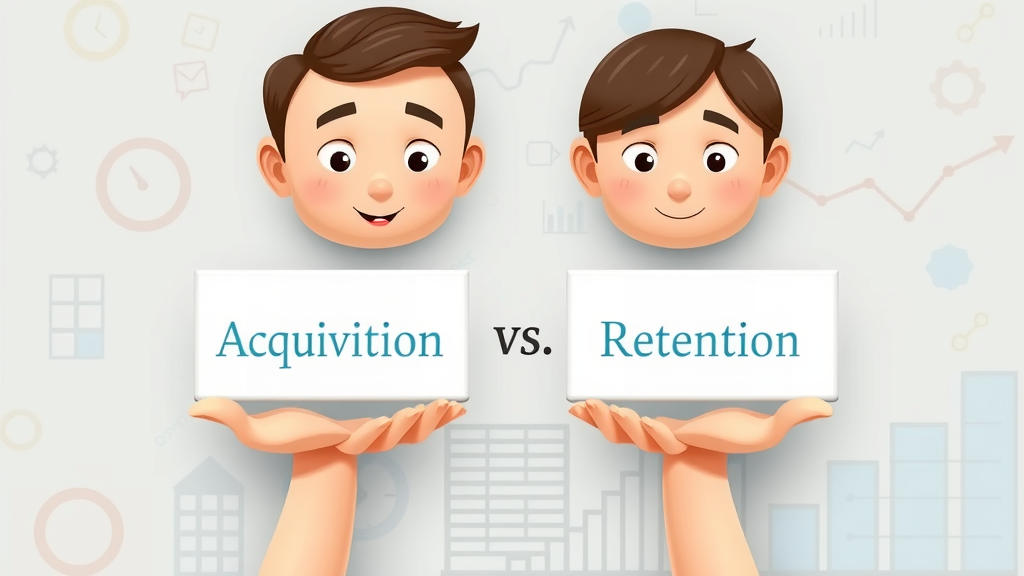What if you discovered that the majority of your profits come from the customers you already have—not the new ones you’re chasing? As digital businesses multiply and online competition tightens, customer retention online has become the critical difference between thriving brands and those struggling to stay afloat. In this comprehensive guide, you'll learn why keeping your existing customers is more profitable than bringing in new ones, how to boost your retention rates, and the actionable strategies successful brands use to make sure customers keep coming back. Get ready for insights that will help you stop losing sales—starting now.

Why Customer Retention Online Matters: The Alarming Cost of Losing Sales
"Did you know that increasing customer retention rates by just 5% can boost profits up to 95%?" - Harvard Business Review
When digital businesses ignore the importance of customer retention online , the price is steep. Every lost customer represents lost revenue, turbulent business growth, and a constant need to pour money into new customer acquisition. These costs compound quickly, eating into profits and disrupting long-term success. Not only do repeat customers spend more than new ones, but loyal customers also act as brand advocates—helping bring in new business for free.
Failing to prioritize retention leads to higher marketing costs as advertising is needed to fill the gap, while the churn rate climbs. This means more effort spent on reacquisition rather than keeping current customers engaged and satisfied. Savvy businesses recognize that building loyal customers through optimized retention strategies not only boosts repeat purchases but safeguards the stability and reputation of your brand online.
- Lost revenue from customers never returning
- Unstable growth due to inconsistent repeat purchases
- Higher marketing costs as acquisition takes priority over retention
Unlocking What You’ll Learn About Customer Retention Online
- Fundamental concepts powering customer retention online
- Retention strategies that work for digital businesses
- Practical steps to shape your retention strategy
- Understanding customer journey and customer experience improvement
- How to boost your retention rate and lower customer churn
- Real examples, actionable checklists, and best practices

The Fundamentals of Customer Retention Online
Defining Customer Retention Online and Its Unique Challenges
Customer retention online refers to a business’s ability to keep its digital customers coming back and making repeat purchases over time. While it often parallels traditional ideas, the online environment introduces unique challenges: digital customers are only a click away from competitors, their loyalty can be fleeting, and they expect seamless experiences across devices. Key challenges include addressing high churn rates due to low brand switching costs and the noise of competing online offers.
In today’s crowded digital space, a user’s experience is often reduced to a fleeting impression—fast loading times, personalized offers, or the speed of your customer service can determine if they return. Effective customer retention strategies combat these challenges with tools like in-depth customer journey mapping, continuous feedback loops, and proactive engagement, all designed to keep customers engaged and onboard.
Recognizing these unique hurdles is the first step in designing a customer retention strategy tailored to digital business models. Brands that truly understand and address the reasons customers leave—a poor customer experience, impersonal interactions, or lack of engagement—are well-positioned to reduce customer churn, increase loyalty, and maximize their online growth potential.
How Customer Retention Online Impacts Your Bottom Line
Focusing on customer retention online significantly improves your bottom line. Repeat customers spend more, have higher average order values, and cost less to market to than new customers. Studies show that acquiring new customers is 5-25 times more expensive than keeping existing ones, highlighting the financial efficiency of retention over acquisition.
Notably, a strong retention rate stabilizes your revenue, allowing for predictable sales forecasting and less reliance on costly promotional campaigns. Loyal customers provide invaluable feedback, contribute to social proof through testimonials and reviews, and are more likely to refer friends and family—further enhancing your marketing reach at little to no added cost. For digital brands, a carefully crafted retention strategy moves the needle on both short-term sales spikes and long-term sustainable growth.
Investing in retention also creates a positive feedback loop: satisfied repeat customers are more likely to try new products, participate in loyalty programs, and defend your reputation on social media. The ripple effect extends beyond numbers—it fosters a community, a brand story, and a foundation for continued innovation.
| Retention | Acquisition | |
|---|---|---|
| Cost per Customer | $1 (avg.) | $5-$25 (avg.) |
| ROI Timeline | Short (immediate repeat purchase) | Long (initial trust-building required) |
| Impact on Revenue | High (creates loyal customer base) | Variable (single purchase focus) |

Understanding the Customer Journey for Online Businesses
Mapping the Online Customer Journey
Every online business should invest time in mapping the customer journey —a process that outlines every step a customer takes, from discovering your brand to becoming a loyal advocate. The digital customer journey consists of key touchpoints that shape the customer experience and ultimately influence retention rates. Understanding these stages enables businesses to strategically intervene, providing value at each turn and minimizing customer churn.
At the awareness stage , prospects first hear about your brand—maybe via social media, ads, or recommendations. The consideration stage is where potential buyers compare options, scrutinize reviews, and evaluate your offerings. The decision stage sees them making a purchase. Crucially, the journey continues post-purchase with onboarding, customer support, and even re-engagement campaigns aiming to convert one-time buyers into loyal customers who keep coming back.
- Awareness
- Consideration
- Decision
- Post-Purchase
- Re-engagement
Effective online businesses deploy tailored touchpoints at each stage—personalized emails during onboarding, targeted social media ads for re-engagement, or feedback requests for ongoing improvement. By optimizing each phase, you set the stage for higher retention rates and a positive, memorable customer experience.
Optimizing Customer Experience to Foster Retention Online
Building a remarkable customer experience online is about reducing friction and delighting the customer at every interaction. Fast navigation, intuitive design, personalized recommendations, and seamless checkout processes all contribute to keeping customers engaged and satisfied. The ease of digital communication also means support should be prompt and empathetic—customers expect answers within hours, not days.
Modern digital businesses leverage customer data to anticipate needs, sending personalized product suggestions or discounts that encourage repeat purchase. Furthermore, thoughtful engagement extends beyond transactions; post-sale support, loyalty programs, and proactive feedback collection tell customers they’re valued. These strategies, when delivered consistently, cultivate trust and transform one-time shoppers into loyal customers who advocate for your brand online.
Ultimately, optimizing the customer experience online doesn’t just reduce churn rate—it builds lasting emotional connections that drive word-of-mouth and fuel organic growth. Smart brands know that every click, scroll, and swipe can impact whether a customer chooses to return or try a competitor.

The Best Customer Retention Strategies for Online Success
Personalization and Segmentation in Retention Strategy
Personalization sits at the heart of effective retention strategies . Today’s customers expect brands to know their preferences, purchase histories, and browsing habits. Using data-driven segmentation, businesses can deliver customized experiences—like individualized product recommendations, exclusive deals, or tailored content—that keep customers engaged. This attention to detail significantly increases repeat purchases and customer loyalty.
Implementing smart segmentation allows brands to group customers by behaviors, needs, or value—either based on how often they buy, what they buy, or their engagement with your site and emails. By speaking to customers differently based on their stage in the journey, businesses can send the right message at the right time, making each interaction more meaningful and boosting retention rates.
The result? Personalized communications create memorable experiences and set your brand apart in a crowded online market. Customers feel understood and appreciated, which transforms routine transactions into long-term relationships.
Loyalty Programs: Building Loyal Customers and Maximizing Retention Rate
A thoughtfully designed loyalty program is a cornerstone of customer retention online. Reward points, tiered benefits, or exclusive perks not only incentivize initial sign-ups but also motivate recurring purchases. Loyal customers enrolled in these programs are statistically more likely to make repeat purchases, advocate for your brand, and engage with promotions.
"A well-structured loyalty program can increase repeat customer transactions by up to 60%."
For online businesses, loyalty programs should be easy to use, seamlessly integrated with your site, and provide clear value for participation. Examples include members-only discounts, birthday rewards, early product access, or points-for-purchase systems. Such programs foster an emotional connection with customers, motivating them to keep coming back while simultaneously boosting your retention rates and overall customer lifetime value.
When communicated effectively through emails, social media, and during the checkout process, these programs enhance both the customer experience and retention strategy, creating a win-win scenario where customers feel valued and businesses enjoy sustained growth.
Leveraging Social Media to Engage Existing Customers
Social media is a powerful channel for keeping customers engaged between purchases. Through active posting, real-time support, and interactive content, brands can maintain an ongoing conversation with both new and loyal customers. Sharing user-generated content, responding to comments, and hosting live Q&As or contests builds a sense of community that deepens emotional investment in your brand.
Creative use of social channels also enables businesses to spotlight loyal customers and encourage referrals. Thoughtfully designed campaigns—such as rewards for social sharing or loyalty program shoutouts—usher positive visibility and strengthen relationships. As social feeds become more integrated with shopping platforms, seamless engagement at every touchpoint can greatly enhance your retention rates.
Finally, social listening offers valuable insights into customer sentiment, enabling quick pivots in retention strategy. Brands that continuously monitor, learn, and react to feedback on social media reinforce trust and ensure customers feel heard, which is essential in reducing churn and keeping your customer base loyal.
Crafting a Referral Program to Boost Customer Retention Online
Referral programs are a retention tactic that not only attract new customers but energize existing ones to act as brand ambassadors. These programs capitalize on your loyal customer base’s trust and enthusiasm by offering incentives when they refer friends or family to your platform. Not only do they increase customer acquisition at a lower cost, but they create a strong sense of belonging among your most loyal customers.
Examples of effective referral programs include offering discounts, bonus loyalty points, or free products when a referred friend makes a purchase. The key is to keep the process simple, rewarding both the referrer and the new customer to foster positive feelings all around. Clear communication and easy sharing capabilities—social media buttons, personalized referral links—make participation more likely and strengthen retention rates for both new and existing customers.
Best Practices for Email in Customer Retention Strategies
Email remains one of the most reliable channels for online customer retention strategies . A well-crafted email campaign can nudge customers back to your site, rekindle lapsed relationships, and deepen loyalty.
- Onboarding sequences
- Re-engagement campaigns
- Personalized offers
Start with automated onboarding to welcome new customers and introduce your brand’s value. Later, use re-engagement emails to win back dormant contacts with personalized reminders or special deals. Custom offers based on individual purchase behavior make customers feel recognized and valued, increasing the likelihood of repeat purchases.
To maximize results, continually test subject lines, sending times, and segmentation rules, and integrate feedback tools so customers can easily share their opinions—helping you iterate and improve your retention tactic over time.

How to Deliver Outstanding Customer Experience and Support
The Role of Customer Service Teams in Customer Retention Online
Your customer service team is the frontline of retention. Online customers expect immediate, helpful responses to queries—whether via live chat, email, or social media. A prompt answer can turn a dissatisfied shopper into a repeat customer, while slow or impersonal service can lead to elevated churn rates and negative word-of-mouth.
Well-trained service teams don’t just resolve issues; they create memorable interactions that reinforce brand loyalty. Empowering agents with the tools and autonomy to make decisions, coupled with empathetic communication, establishes emotional bonds with your customers and enhances the overall retention strategy.
High-performing teams consistently monitor support metrics, adjusting workflows to better serve customer needs and proactively addressing common pain points before they escalate. This approach not only improves satisfaction and retention rates but can also transform ordinary customer service touchpoints into key moments of delight.
Building Customer Support That Decreases Churn Rate
Reducing churn rate starts with investing in robust customer support. This involves creating clear self-service resources—like FAQ sections, help centers, or video tutorials—that empower customers to solve issues on their own. Multiple communication channels (chat, email, phone, social direct messages) increase accessibility and reduce the frustration that can drive customers away.
Proactive support—such as checking in post-purchase to ensure satisfaction or sending reminders for restocking—anticipates needs rather than waiting for a problem to arise. Regular follow-ups and feedback requests let customers know their experience matters, preventing minor issues from turning into lost business.
Finally, tracking key support metrics—response time, resolution rate, and customer effort score—helps your team optimize its approach. Brands that view customer support as a value driver, not just a cost center, see direct improvements in retention rates and customer loyalty.
Measuring Customer Satisfaction and Gathering Customer Feedback
Customer satisfaction is a crucial driver of customer retention online . Measuring it begins with regularly soliciting feedback via surveys, NPS (Net Promoter Score) ratings, and direct outreach. Knowing how customers feel at various touchpoints in their journey enables you to address grievances quickly and identify areas for improvement in your retention strategies.
Organize customer input into actionable insights, sharing them across teams to inform product enhancements, service improvements, or new loyalty program features. Actively responding to feedback—whether positive or negative—builds transparency and trust, enhancing the retention strategy with real substance.
Integrating satisfaction metrics with retention data provides a holistic view of where you excel and where there’s room to do better. Focusing on customer experience not only lowers churn rates but positions your brand as an attentive, reliable partner in the eyes of your online customer base.

Metrics That Matter: Measuring Customer Retention Rate and Churn
How to Calculate Customer Retention Rate Online
Accurately tracking customer retention rate is crucial for measuring your success in keeping customers coming back. The basic formula for retention rate is simple:
| Retention Rate (%) = ((Number of Customers at End of Period – Number of Customers Acquired During Period) ÷ Number of Customers at Start of Period) × 100 |
| Example: Start: 1,000 customers New customers this period: 200 End of period: 1,050 customers Retention rate = ((1,050 - 200) ÷ 1,000) × 100 = 85% |
A high retention rate indicates that your retention strategies are working effectively. Continually tracking these metrics allows you to pinpoint successes and identify opportunities for further boosting customer loyalty and reducing churn rates.
Key Metrics: Repeat Customer Rate, Churn Rate, and CLV
Besides the standard retention rate, consider these pivotal metrics:
- Repeat Customer Rate: The percentage of customers who purchase more than once over a set period. A higher number signals strong brand loyalty and effective retention strategies.
- Churn Rate: The percentage of customers lost during a given time frame. A rising churn rate requires prompt investigation and adjustments to your retention strategy.
- Customer Lifetime Value (CLV): The estimated total worth of a customer throughout their relationship with your brand. Increasing CLV through repeat purchases and reduced churn rate is vital for sustainable profitability.
By balancing these metrics, digital brands gain a granular view of how effectively they’re increasing customer loyalty and keeping existing customers engaged—laying the groundwork for sustainable online growth.

Improving Retention Rates: Real-World Examples
- Case Study: How an eCommerce Brand Increased Customer Retention Online by 30% A mid-size online retailer improved their post-purchase emails, streamlined customer support, and launched a referral program. These modest changes saw their repeat customer rate jump by 30% in just 12 months.
-
Checklist: Steps to Improve Customer Retention Online Today
- Map your current customer journey
- Enhance your onboarding process
- Invest in robust customer support
- Launch or upgrade your loyalty and referral programs
- Use surveys to gather actionable feedback
- Regularly review retention and churn metrics
The 3 R’s of Customer Retention Online
Reward, Recognize, and Retain: What They Mean and Why They Matter
The 3 R’s of customer retention —Reward, Recognize, and Retain—capture the essence of strong online retention strategies. Reward your customers for every purchase or action, making them feel valued. Recognize loyal customers by featuring them in campaigns, highlighting milestones or anniversaries, and thanking them publicly. When you reward and recognize, you naturally retain —fostering a cycle where customers want to stay and keep buying.
These principles underpin every successful loyalty program and are vital to building long-term emotional connections that differentiate your brand in the digital marketplace. Applying the 3 R’s consistently ensures customers feel appreciated and incentivized to engage repeatedly, directly improving retention rates and your bottom line.

The Power of the 80/20 Rule in Customer Retention Online
How 80% of Revenue Comes from 20% of Existing Customers
In the world of customer retention online , the famed 80/20 rule holds true: roughly 80% of your revenues come from just 20% of your existing customers. This means a small core of loyal customers wields disproportionate influence over your profitability. Focusing energy on retention strategies that nurture these high-value clients—by delivering unparalleled experiences, exclusive access, or tailored rewards—delivers an outsized impact on your bottom line.
Understanding this principle helps brands allocate resources wisely, prioritizing efforts such as enhancing loyalty programs, personalizing communications, and building community experiences. The result? Increased average order value, boosted lifetime value, and a powerful engine for sustainable digital growth rooted in customer loyalty, not just acquisition.

Actionable Tactics: How to Retain Your Web Customers
- Improve onboarding for new customers
- Offer excellent customer support across all channels
- Personalize every experience using customer data
- Actively seek and respond to feedback to refine your retention strategy
Implementing these actionable tactics ensures you proactively meet customer needs, anticipate problems before they arise, and create memorable experiences that encourage ongoing engagement. Each step contributes to reducing churn and driving higher returns from your online customer base.
What Is a Good Customer Retention Rate for eCommerce?
Benchmarks and What Top Performers Achieve
A good customer retention rate for eCommerce varies by industry but typically ranges between 25% and 40%. Top performers often boast rates above 40%, signaling robust customer loyalty and exceptional retention strategies. Achieving high retention rates requires continuous improvement—tracking metrics, iterating on programs, and delivering customer experiences that promote repeat purchases.
If your business falls below these benchmarks, focus on foundational steps like mapping your customer journey, boosting personalization, and rolling out compelling loyalty programs. Remember: every small increase in retention rate has a disproportionate impact on profits and long-term growth.
Customer Retention vs. Customer Acquisition: Striking the Right Balance
Why Investing in Existing Customers Drives More Sustainable Growth
While customer acquisition remains vital for any growing brand, investment in customer retention online offers greater efficiency and returns over time. Existing customers are more receptive to upsells, have higher average transaction amounts, and drive organic growth through referrals. Significantly, retaining customers costs far less than acquiring new ones, meaning dollars spent here provide a better ROI.
Brands that neglect retention often see a “leaky bucket” effect—new customers enter as existing ones slip away—leading to stagnant growth. By balancing acquisition with strong retention strategies, you cultivate a loyal customer base that anchors your business, enabling sustainable revenue and expansion.
How to Align Retention Strategy With Growth Objectives
To drive strong growth, your retention strategy must be tightly aligned with wider business goals. Start by analyzing key metrics—retention rate, churn rate, and CLV—to determine which customer profiles deliver the highest value. Tailor your retention strategies (loyalty programs, personalization, support) to these segments, while ensuring acquisition efforts bring in prospects likely to become repeat customers.
Cross-functional collaboration—sales, marketing, product, and support teams all focused on the same retention objectives—ensures consistency and reinforces customer-centricity at every touchpoint. Regularly test new initiatives and use data to iterate, keeping a constant feedback loop between marketing innovation and measurable retention improvements.

Common Mistakes That Hurt Customer Retention Online
- Neglecting existing customers after the first purchase
- Poor or inconsistent customer experience
- Ineffective loyalty programs that do not excite or reward
- Lack of personalization in communications and offers
Avoiding these pitfalls ensures superior customer retention online and a stronger brand reputation in the digital landscape.
Future Trends in Customer Retention Online
AI and Automation Transforming the Customer Experience
The rise of AI and automation is set to revolutionize customer retention online. Automated chatbots, personalized recommendation engines, and predictive analytics all help digital businesses offer 24/7 support, anticipate customer needs, and deliver hyper-personalized experiences at scale. By streamlining repetitive tasks, AI frees up human agents for complex interactions, improving both efficiency and satisfaction.
These technologies analyze behavioral data in real time, dynamically adjusting retention strategies based on customer actions. The result: reduced churn rates, more meaningful interactions, and a competitive edge for brands who innovate fast.
Personalized Marketing and Data-Driven Retention Strategies
Future retention strategies will rely even more on data-driven marketing—using purchase history, browsing behavior, and feedback to deliver tailored offers and experiences. Advanced segmentation and predictive modeling allow brands to identify customers at risk of churning and intervene with targeted incentives or personalized communication.
As privacy expectations rise, successful digital brands will also focus on transparency and ethical data practices. Those who strike the right balance will enjoy loyal customers, higher retention rates, and ongoing trust—essential commodities in tomorrow’s digital marketplace.

Expert Quotes on Customer Retention Online
"Customer retention is the new acquisition." - Forbes
"Retention strategies are evolving with technology—winning brands adapt fast." - Digital Commerce 360
Frequently Asked Questions on Customer Retention Online
What are the 3 R's of customer retention?
The 3 R's— Reward , Recognize , and Retain —are fundamental principles for building long-term customer loyalty online. Reward customers for their loyalty with perks and benefits, recognize their importance through personalized engagement and public acknowledgment, and focus on retaining them with ongoing value and excellent experiences.
What is the 80 20 rule in customer retention?
The 80/20 rule states that about 80% of revenue often comes from just 20% of customers. In practice, this means focusing your retention strategy and customer experience efforts on keeping your highest-value customers loyal, as they make the biggest impact on your business growth and profitability.
How to retain your web customer?
Retain web customers by offering stellar onboarding, personalizing content and offers based on their behavior, responding quickly to feedback, and providing easy access to customer support. Consistent engagement through email, loyalty programs, and social media also keeps your brand top of mind and encourages repeat purchases.
What is a good customer retention rate for eCommerce?
A typical customer retention rate for eCommerce ranges from 25% to 40%. Businesses with rates above 40% are considered top performers. Regularly reviewing your retention strategies, collecting customer feedback, and improving the digital experience are key to increasing your retention rate over time.
Essential Customer Retention Online Checklist
- Audit current retention rates and strategies
- Map customer journey online
- Enhance customer experience and support
- Implement or refine loyalty and referral programs
- Measure, test, and improve retention tactics regularly

Key Takeaways for Improving Customer Retention Online
- Customer retention online is critical for profitability and business growth
- Personalization, customer experience, and solid strategies drive retention rates
- Regular analysis and proactive customer engagement are essential
Watch: Video Insights on Customer Retention Online (1/3)
Watch: Social Media’s Role in Customer Retention Online (2/3)
Watch: Retention Strategies in Practice (3/3)
Ready to Stop Losing Sales? Take the Next Step Toward Exceptional Customer Retention Online
- Assess your current retention strategy
- Implement recommended tactics
- Track your progress
- Reach out for expert support to maximize your customer retention online
 Add Row
Add Row  Add
Add 




Write A Comment